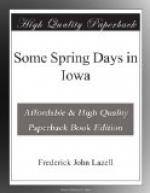After bringing us the trilliums and hepaticas in numbers, Nature pauses. She means to give us time to inhale the fragrance of some of the hepaticas, and to learn that other hepaticas of the same species have no fragrance at all; that there is a variety of delicate colors, white, pink, purple, lavender, and blue; that the colored parts, which look like petals are really sepals; that they usually number six, but may be as many as twelve; that there are three small sessile leaves forming an involucre directly under the flower; that if we search we shall find some with four, more rare than four-leaved clovers; that the plant which was fragrant last year will also be fragrant this year; that the furry stems are slightly pungent,—enough to give spice to a sandwich; these preliminary observations fit us for more intricate problems later on.
* * * * *
Spenser, the divinely tongued, pictures April as a lusty youth, riding upon the bull with the golden horns (Taurus), wading through a flood, and adorned with garlands of the fairest flowers and buds. A better figure would have been Europa riding Zeus. And Chaucer also makes April a masculine month:
"When that Aprille with his schoweres
swoote
The drought of Marche had
perced to the roote."
But surely April, with her smiles anl[TN-1] tears, ought to be regarded as a feminine month. Ovid has shown that she was not named from aperire, to open, as some have supposed, but from Aphrodite, the Greek name for Venus, goddess of beauty and mother of love. She is chaste, even cold, but grows sweeter and more affectionate every day and her tears all end in smiles. Her flowers are pure and mostly white, fitting for a maiden. Look at the list (if the weather is warm):
White or whitish:—Rue-anemone, hepatica, spring beauty, blood-root, toothwort, Dutchman’s breeches, dog’s tooth violet, wild ginger, chickweed, Isopyrum, plantain-leaved everlasting, shepherd’s purse, shad-bush, wild strawberry, whitlow-grass, wind-flower, hackberry (greenish white), false Solomon’s seal, catnip, spring cress, wild black currant, wild plum.
Yellow or yellowish:—Marsh marigold, creeping buttercup, marsh buttercup, small-flowered crowfoot, dandelion, yellow woodsorrel, bell-wort, star-grass, downy yellow violet, pappoose root, lousewort, prickly ash, hop hornbeam, white oak, mossy-cup oak, butternut, sugar maple.
Purple or blue:—Common blue violet, trillium (recurvatum and erectum) hepatica, Virginian cowslip (lung-wort or bluebells), woodsorrel, common blue phlox, ground plum.
Green:—The Indian turnip, and several of the sedges.
Pink:—Spring beauty, toothwort, dog’s tooth violet, hepatica.
Scarlet:—Columbine.
From this list it ought to be plain that April is a dainty queen, wearing a dress of cheerful green, a bodice of white, with violets in her hands, pink in her cheeks, and a single scarlet columbine in her wealth of golden hair, which indeed comes nearly being the portrait of Dione herself. Or, as one of the poets has better described her:




